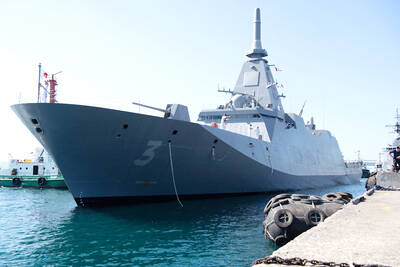After a mayor waited five years in vain for Filipino politicians to make good on a promise to build a badly needed health clinic in Calbayog, US Navy Seabees helped local troops construct it — in just 30 days.
The Seabees, the Navy’s construction units, arrived weeks ahead of the hospital ship USNS Mercy, which visited impoverished Calbayog for the second time on Saturday after treating thousands of people for free in 1987.
When the huge, white-hulled Mercy — a converted oil tanker — steamed back to Calbayog, on central Samar Island, a boy who underwent surgery aboard the ship 21 years ago to correct a foot deformity waited on shore. Now a nurse, he wanted to give a little payback to the Americans.
“I offered to become a medical volunteer as a way of thanking them. I can walk now because of the Mercy, I can even play basketball,” an excited Carl Nino Rosalado said.
The Mercy’s gentle diplomacy has won hearts in the Philippines, where the US military has been providing combat training and weapons to the underfunded military since 2002 to stop the poor Southeast Asian country from continuing to be a breeding ground for terrorists and extremist ideologies.
Al-Qaeda-linked Abu Sayyaf militants in the south have been weakened by US-backed offensives but still plot bombings and kidnappings for ransom. They have been blamed for the June 8 kidnapping of a TV news anchor and her two-man crew on violent Jolo island.
Communist New People’s Army guerrillas have been waging a 40-year bloody insurrection across the sprawling archipelago, including on Samar, about 600km southeast of Manila.
Both insurgent groups, blacklisted by Washington as terrorist organizations, have targeted Americans in the past.
Wrapping up a monthlong medical and civic mission in the Philippines — the first stop in a five-nation Asia-Pacific humanitarian tour — the Mercy’s staff, Seabees, US Ambassador Kristie Kenney and other US officials were given a rousing tribute on Saturday by Calbayog, a laid-back coconut-growing and fishing city.
Hundreds of elementary and high school students — in their school uniforms on a day without classes — lined roads, yelling and waving small US and Philippine flags as Kenney’s convoy passed by. A local army brass band welcomed her at the airport and cultural dancers, including a group of villagers dressed as roosters, regaled the Americans in two farewell performances.
Kenney got out of her van a number of times, shaking the hands of well-wishers and giving them high-fives. She later inaugurated a nine-room health center partly built by 20 Seabees, which Calbayog Mayor Mel Sarmiento said would boost a local government campaign against tropical diseases, dengue and tuberculosis.
Calbayog already has one public and three private hospitals, but its six government doctors are overwhelmed by the poor, who make up nearly half of the 164,000 residents, he said.
“If we have enough medical services, medicine for the sick and free consultations, maybe the rebels will come down from the mountains,” said Lucena Mendoza, a mother of four who waited in line nine hours for treatment for blurred vision from a US volunteer ophthalmologist.
She left beaming with new reading glasses.
Reaching out to the rural poor entails risks for Mercy’s medical workers.
In Calbayog, near mountains where communist guerrillas lurk, heavily armed soldiers and police kept watch over the Americans.
In an earlier stop in the south, one of the Mercy’s four MH-60 Knighthawk support helicopters was hit by gunfire although it is not certain it was targeted or accidentally hit in a region where Muslim rebels and criminal gangs also are active.
Nobody was injured. The helicopter was grounded for safety checks and only one civic activity was canceled. The Mercy’s mission went on.
During a 2006 visit, the Mercy anchored far from southern Jolo Iisland, where Abu Sayyaf extremist militants are active, for security reasons. Police said at the time they had learned of a plan by the militants to bomb the ship, which was given 24-hour heavy security.
While many in predominantly Muslim Jolo still harbor bitter memories of bloody battles between their forefathers and US colonizers in the early 1900s, it was hard to find anyone in Calbayog who could recite similar fighting on Samar.
In 1901, Filipino insurgents attacked and killed several US occupation troops in Samar’s Balangiga township, near Calbayog. The so-called “Balangiga massacre” — and the heavy-handed US reprisal that followed — represented one of the lowest points in the history of the two nations, which would later become strong military allies.
After stopping in Manila for another medical mission yesterday, the Mercy will travel to Vietnam, East Timor, Papua New Guinea and Micronesia, US Navy Captain James Rice said.

Nauru has started selling passports to fund climate action, but is so far struggling to attract new citizens to the low-lying, largely barren island in the Pacific Ocean. Nauru, one of the world’s smallest nations, has a novel plan to fund its fight against climate change by selling so-called “Golden Passports.” Selling for US$105,000 each, Nauru plans to drum up more than US$5 million in the first year of the “climate resilience citizenship” program. Almost six months after the scheme opened in February, Nauru has so far approved just six applications — covering two families and four individuals. Despite the slow start —

MOGAMI-CLASS FRIGATES: The deal is a ‘big step toward elevating national security cooperation with Australia, which is our special strategic partner,’ a Japanese official said Australia is to upgrade its navy with 11 Mogami-class frigates built by Japan’s Mitsubishi Heavy Industries, Australian Minister for Defence Richard Marles said yesterday. Billed as Japan’s biggest defense export deal since World War II, Australia is to pay US$6 billion over the next 10 years to acquire the fleet of stealth frigates. Australia is in the midst of a major military restructure, bolstering its navy with long-range firepower in an effort to deter China. It is striving to expand its fleet of major warships from 11 to 26 over the next decade. “This is clearly the biggest defense-industry agreement that has ever

DEADLY TASTE TEST: Erin Patterson tried to kill her estranged husband three times, police said in one of the major claims not heard during her initial trial Australia’s recently convicted mushroom murderer also tried to poison her husband with bolognese pasta and chicken korma curry, according to testimony aired yesterday after a suppression order lapsed. Home cook Erin Patterson was found guilty last month of murdering her husband’s parents and elderly aunt in 2023, lacing their beef Wellington lunch with lethal death cap mushrooms. A series of potentially damning allegations about Patterson’s behavior in the lead-up to the meal were withheld from the jury to give the mother-of-two a fair trial. Supreme Court Justice Christopher Beale yesterday rejected an application to keep these allegations secret. Patterson tried to kill her

MILITARY’S MAN: Myint Swe was diagnosed with neurological disorders and peripheral neuropathy disease, and had authorized another to perform his duties Myint Swe, who became Myanmar’s acting president under controversial circumstances after the military seized power from the elected government of Aung San Suu Kyi more than four years ago, died yesterday, the military said. He was 74. He died at a military hospital in the capital, Naypyidaw, in the morning, Myanmar’s military information office said in a statement. Myint Swe’s death came more than a year after he stopped carrying out his presidential duties after he was publicly reported to be ailing. His funeral is to be held at the state level, but the date had not been disclosed, a separate statement from the